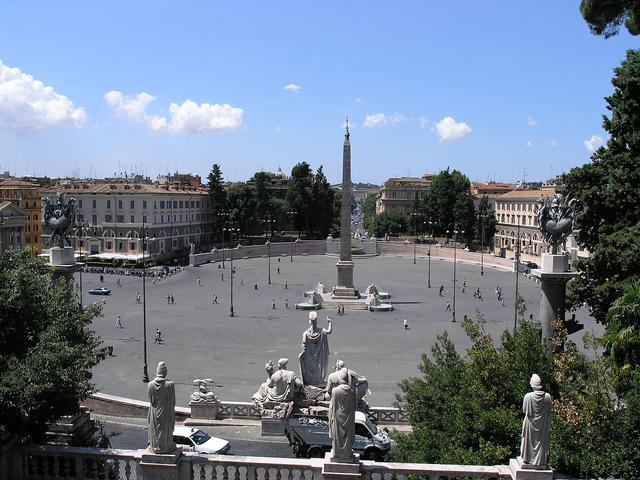Town square

Piazza del Popolo is not just a large urban square in Rome, but a historical and cultural landmark that has played a significant role in the city's history. The name "People's Square" in modern Italian may seem straightforward, but its origins are rooted in the presence of poplar trees in the area. The square is home to the beautiful church of Santa Maria del Popolo, located in the northeast corner, which also lends its name to the square.
Situated within the northern gate of the Aurelian Walls, known as the Porta Flaminia in ancient Rome and now called the Porta del Popolo, the square holds a special place in the hearts of Romans and visitors alike. It served as the starting point of the Via Flaminia, a crucial road leading to Ariminum (modern Rimini) and a key route to the north. Before the advent of railways, Piazza del Popolo was often the first glimpse of Rome that travelers would behold upon their arrival. However, the square also has a darker history, having been a site for public executions for many centuries, with the last one taking place in 1826.
One of the most striking features of Piazza del Popolo is the Egyptian obelisk of Sety I, which was relocated to the center of the square by Pope Sixtus V in 1589. This impressive 23.2-meter-tall obelisk dates back to around 1300 BC and originally stood in the Temple of the Sun at Heliopolis. Emperor Augustus brought it to Rome in 10 BC to commemorate the conquest of Egypt. The obelisk is surrounded by four majestic Egyptian lions, added by Giuseppe Valadier during his redesign of the square in 1815-1816. Valadier also introduced the oval shape of the square, along with the central fountain and the walls adorned with statues of sphinxes, all of which contribute to the square's unique charm and historical significance.
As you wander through Piazza del Popolo, take a moment to appreciate the blend of ancient Egyptian and Roman influences that converge in this iconic square. The obelisk, lions, and sphinxes stand as testaments to the enduring legacy of these ancient civilizations, while the surrounding architecture and churches offer a glimpse into the rich history of Rome. Whether you're a history buff, an art enthusiast, or simply a curious traveler, Piazza del Popolo is sure to captivate you with its beauty and historical significance. Don't miss the opportunity to explore this vibrant square and immerse yourself in the stories and legends that have shaped Rome over the centuries.
© ChatGPT 3.5
Between the elegant Pincio and the banks of the Tevere, Piazza del Popolo opens in a huge ellipse. Churches, fountains, monuments and marble memories of historical events in Rome, both ancient and modern, tastefully embellish the square.
Since ancient times, the northern entrance to the city formed a vestibule to the city through the Aurelian Walls gate. Although it is now known as Porta del Popolo, it has had several names over the centuries.
Originally called Porta Flaminia after the Emperor Aurelianus who commissioned its construction, during the early Medieval period, it was called Porta San Valentino, after the nearest Catacomb. Finally the name Porta del Popolo was agreed upon, since the church next to the door is Santa Maria del Popolo.